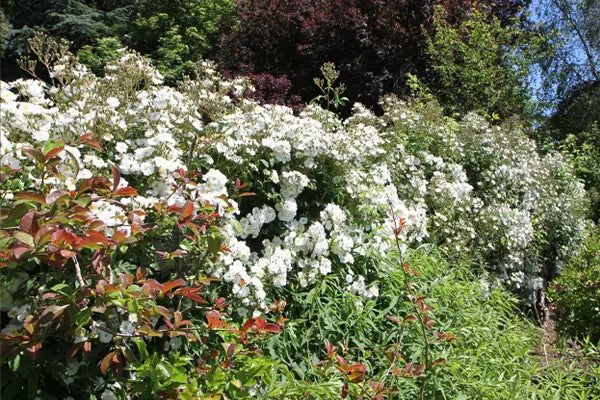Only 14 Left
Sold as:
Bulbs
from £11.95
Only 5 Left
Sold as:
Bulbs
from £5.95
Out of Stock
Sold as:
Potted
Bareroot
from £7.99
01/10/2025
Rambling roses are much more wild in their DNA than Climbing roses, and this shows in their appearance.

The easiest way to tell a Climber and a Rambler apart is to see how they bloom:
If you are looking at the rose in late Summer or early Autumn, and it’s covered in thousands of rose-hips, it’s probably a Rambler.
If it still has flowers or the recent remnants of faded flowers, it’s probably a Climber

Rambling roses are less demanding than Climbers, and are the best choice for poorer soils and dappled shade.
Rambling Roses are chiefly derived from 4 groups of wild rose: Rosa multiflora, R. setigera, R. sempervirens, and R. wichurana.
They are more vigorous, will cover a greater area, and are ideal for interweaving through trees, covering unattractive oil tanks and disguising wooden fencing, but be sure that the fencing is strong enough!
Their vigour can make them hard to contain. Ramblers usually flower once a year on the shoots that grew last year. Some produce a blizzard of small to medium flowers. As with most rules, there is an exception; The Lady of the Lake is a lovely rambling rose that does repeat flower from late spring to autumn.
Pruning is simple in that in any one year, you only need to cut back the shoots that are encroaching into your gutters or pathways.
A bit of trimming side shoots after flowering will help, but is not essential.
Whenever a mature plant, older than about six years, gets crowded, remove some old stems once they have flowered and look for the best new stems to position or tie in their place.
Again, this is best done yearly if you want the best flower shows, but every few years is also fine: it depends on what you want to do with the plant.
To restore an overgrown rambler, cut all the old stems to the ground, leaving almost all the one and two-year-old growth; only cut out the very weakest stems.
Climbing Roses are an oddball category in that they are variants of pretty much all the other modern rose groups, selected for their freakishly long canes.
A famous example of this is the floribunda shrub ‘Iceberg’, and its ‘Climbing Iceberg’ version.
As a consequence, climbers’ flowers are often more showy, benefit from being viewed from below as they droop slightly, and they often repeat or seem to flower continuously, especially if you can deadhead the spent flowers.
Climbing roses really need a yearly trim to stay in good form; each side shoot that flowered should be cut back by two-thirds.

To restore an overgrown climber, cut the oldest stems to the ground, leaving about five or six of the “youngest mature” stems to use as the framework for the new growth. Apart from the five or six younger stems that you keep, remove all other young shoots.
All of that energy expended on flowering twice means that climbers will not generally grow as tall as ramblers.
They also produce fewer shoots each year, which need to be trained in a balanced fan shape.
Climbing roses also insist on a more exacting pruning regime to ensure maximum floral impact; more on rose pruning.
Wherever possible, you should train climbing rose canes diagonally so they produce more flowering shoots. A vertical stem will only flower at the top.
They say that you give the presents that you actually want for yourself.
I am not sure that that is right, because one of the best presents I have received was ten bare root David Austin roses from a non-gardener friend of mine who dislikes roses as a flower because of the hidden thorns behind those innocent blooms.
The pack included a mixture of rambling roses and climbing roses. Two years later, only one had died; my fault, because I planted it next to an existing climbing rose.
I fondly imagined that they would intertwine and look glorious, but instead the new rose shrivelled and died due to “replant disease”.
As a rule, if you have to plant a rose (or most other plants) where a previous rose (or whatever) existed or exists, you need to dig deep and change the surrounding soil entirely for the incomer to survive. The others roses remain in fine fettle because I put them somewhere where they would flourish.
My present included a pink pom-pom type – Rosa Felicite Perpetue. I now have it climbing through a Beurre Hardy pear tree that grows against a west-facing wall, and has wonderful blossom.
The roses would perpetuate (just like the name) the “blossom” well into June. It worked well and so the next stage, a little like layering clothes in the shoulder seasons, is to keep the wall interesting by adding a clematis or two.
My preference will be to use an early flowering clematis to contrast with the white pear blossom, and then a late, deep red clematis like ‘Niobe’ (maybe the most beautiful large-flowered clematis?) to complement the Astrantia ‘Claret’ and Hydrangea paniculata ‘Limelight’ growing below.
My surprise rambler was Rosa ‘Narrow Water’. It flowers just about non-stop from June until the first frosts. In spring, and again in late Summer the true pink of Narrow Water is beautifully complemented by another clematis – The President. Simply stunning.